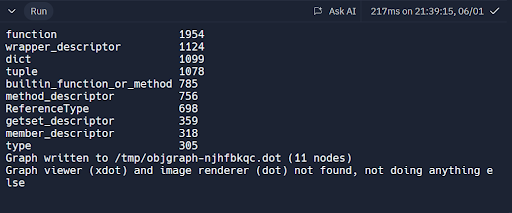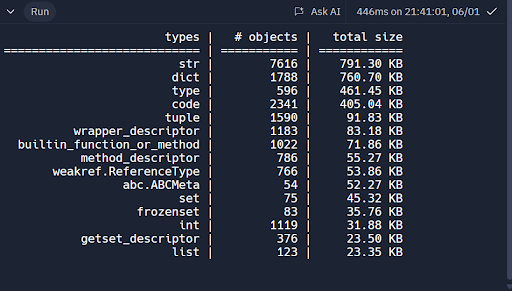Introduction
Creating high-performing and environment friendly apps requires optimizing reminiscence utilization within the current software program growth atmosphere. Reminiscence profiling is an environment friendly method for conducting this. Reminiscence profiling examines a program’s reminiscence utilization and finds memory-intensive code segments, attainable reminiscence leaks, and optimization prospects. This process aids programmers in ensuring their apps make the most of reminiscence successfully, leading to faster and extra scalable processes. This text is an introductory information for reminiscence profiling in Python.
What’s Reminiscence Profiling?
Reminiscence profiling is the strategy of analyzing software program to find out how a lot reminiscence it makes use of. It helps determine memory-intensive code segments, potential reminiscence leaks, and potential optimization targets. By profiling reminiscence, builders might make sure that their purposes use reminiscence effectively and obtain quicker and extra scalable operations.
Significance of Reminiscence Profiling
- Efficiency Enchancment: Builders can improve an utility’s pace and responsiveness by figuring out memory-intensive duties and optimizing the code.
- Useful resource Administration: When reminiscence is used effectively, purposes grow to be extra strong and scalable, lessening the pressure on system assets.
- Debugging Reminiscence Leaks: Reminiscence leaks, which might finally trigger crashes or sluggish efficiency, may be discovered and stuck utilizing reminiscence profiling.
Benefits of Reminiscence Profiling in Python
- Figuring out Bottlenecks: Reminiscence profiling aids in finding code segments that use extreme quantities of reminiscence. Thus, permitting programmers to change such sections for elevated effectivity.
- Leak Detection: Reminiscence profiling instruments can determine reminiscence leaks, which occur when reminiscence not required is stored in reserve. Therefore finally rising reminiscence utilization.
- Predictable Conduct: Reminiscence profiling contributes to regular reminiscence utilization, stabilizing and producing extra predictable utility conduct.
- Lengthy-term Reliability: Steady reminiscence profiling can make sure that long-running purposes stay dependable and environment friendly over time.
- Code Refactoring: Profiling can spotlight inefficient code. Subsequently, prompting builders to refactor and enhance the general code high quality.
Disadvantages of Reminiscence Profiling in Python
- Elevated Runtime: Reminiscence profiling might trigger the applying to execute with extra overhead. Subsequently, ensuing in a slower profile in the course of the profiling course of.
- Code Modification: Some profiling instruments require including decorators or sure perform calls to the code. Thus, it may be invasive and influence the codebase.
- Restricted Scope: Some reminiscence profiling instruments might present solely a partial view of reminiscence utilization, probably lacking points that manifest beneath particular circumstances or workloads.
- Snapshot Limitations: Instruments that depend on snapshots won’t seize transient reminiscence utilization spikes, resulting in incomplete evaluation.
- Inaccurate Studies: Profiling instruments may typically report false positives or negatives, particularly in advanced purposes, resulting in misdirected optimization efforts.
A number of instruments can be found for Python reminiscence profiling, every with distinctive capabilities and purposes. We take a look at a couple of of the extra well-known ones right here.
1. memory_profiler
One widespread device for monitoring reminiscence consumption is memory_profiler. It gives line-by-line info on reminiscence use. Thus simplifying the identification of memory-intensive parts of the code.
Options
- Line-by-Line Evaluation: Permits detailed inspection of reminiscence utilization at every line of code.
- Ease of Use: Easy to combine with Python code utilizing decorators.
- Integration with IPython: This can be utilized with IPython for interactive profiling.
Set up
pip set up memory-profilerUtilization
To make use of memory_profiler, beautify the perform you need to profile with @profile And run the script with the -m memory_profiler Flag.
from memory_profiler import profile
@profile
def my_function():
a = [1] * (10**6)
b = [2] * (2 * 10**7)
del b
return a
if __name__ == "__main__":
my_function()Output

Working this script will produce an in depth reminiscence utilization report for every line within the embellished perform.
2. guppy3
guppy3 is a complete Python programming atmosphere with a heap evaluation toolset. It features a heap evaluation device for locating reminiscence leaks and analyzing reminiscence utilization.
Options
- Heap Evaluation: Detailed heap utilization stories and evaluation.
- Debugging Reminiscence Leaks: Efficient in figuring out reminiscence leaks.
- Interactive Use: This can be utilized interactively for in-depth evaluation.
Set up
pip set up guppy3Utilization
from guppy import hpy
hp = hpy()
heap = hp.heap()
print(heap)Output

3. tracemalloc
tracemalloc is a built-in module in Python that tracks reminiscence allocations. It gives statistical reminiscence utilization evaluation. Moreover, it may be helpful for monitoring reminiscence leaks.
Options
- Constructed-in: No want for extra installations.
- Snapshot Comparability: Examine reminiscence utilization snapshots to determine adjustments.
- Detailed Studies: Gives detailed stories on reminiscence allocation.
Utilization
import tracemalloc
tracemalloc.begin()
# Your code right here (exchange with precise code whose reminiscence utilization you need to monitor)
# For instance, creating a big listing:
knowledge = [x ** 2 for x in range(100000)]
snapshot1 = tracemalloc.take_snapshot()
# Your code right here (exchange with precise code whose reminiscence utilization you need to monitor)
# For instance, modifying the listing:
knowledge = [x ** 3 for x in range(100000)]
snapshot2 = tracemalloc.take_snapshot()
top_stats = snapshot2.compare_to(snapshot1, 'lineno')
for stat in top_stats[:10]:
print(stat)Output

4. objgraph
objgraph is a module that permits you to visually discover Python object graphs. It will possibly assist discover reminiscence leaks by figuring out objects which can be taking over reminiscence. Moreover, it could actually assist in monitoring down why they don’t seem to be being rubbish collected.
Options
- Visible Illustration: Generates visible representations of object graphs.
- Discovering Leaks: Helps determine objects which can be inflicting reminiscence leaks.
- Interactive: Utilizing it interactively to discover object relationships.
Set up
pip set up objgraphUtilization
import objgraph
# Your code right here
# For instance,
# Outline a pattern class
class MyClass:
def __init__(self, worth):
self.worth = worth
# Create cases of the category
obj1 = MyClass(10)
obj2 = MyClass(20)
obj3 = MyClass(30)
# Assign one of many objects to a variable for inspection
some_object = obj1
objgraph.show_most_common_types()
objgraph.show_backrefs([some_object], max_depth=10)Output

5. pympler
pympler is one other highly effective device for monitoring reminiscence utilization in Python applications. It gives detailed stories, and furthermore, it could actually assist analyze the lifetime of Python objects.
Options
- Complete Studies: Gives detailed reminiscence utilization stories.
- Monitoring Object Lifetimes: Tracks the lifetime of Python objects.
- Integrates with Present Code: This may be built-in for steady monitoring.
Set up
pip set up pymplerUtilization
from pympler import abstract, muppy
all_objects = muppy.get_objects()
sum1 = abstract.summarize(all_objects)
abstract.print_(sum1)Output

Finest Practices for Reminiscence Profiling
- Profile Often: Combine reminiscence profiling into your growth workflow to catch reminiscence points early.
- Optimize Knowledge Constructions: Select the appropriate knowledge constructions that steadiness reminiscence utilization and efficiency.
- Monitor Lengthy-Working Functions: Constantly monitor reminiscence utilization in purposes that run for prolonged intervals.
- Use Reminiscence Swimming pools: Implement reminiscence swimming pools to handle reminiscence allocation and deallocation effectively.
Additionally Learn: Generate Studies Utilizing Pandas Profiling
Conclusion
Subsequently, reminiscence profiling is important for growing environment friendly and strong Python purposes. Through the use of instruments like memory_profiler, guppy3, tracemalloc, objgraph, and pympler, builders can find out about their purposes’ reminiscence consumption patterns and regulate them accordingly. Frequent reminiscence profiling enhances effectivity, guards towards reminiscence leaks, and ensures that apps perform correctly.
If you wish to study extra about Python, do Analytics Vidhya’s Python course.












![Why Ethereum [ETH] address outflows may be headed for DeFi](https://cryptonoiz.com/wp-content/uploads/2023/03/AMBCrypto_An_image_of_a_stylized_Ethereum_logo_with_arrows_poin_22f2aeff-c7bb-4c7d-aec7-547a37a35e82-1-1000x600-360x180.jpg)























